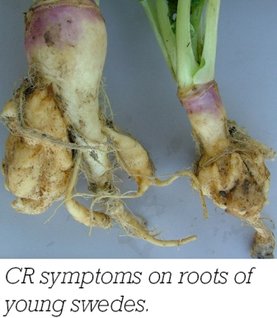Club root (CR)
CR, caused by the fungus Plasmodiophora brassicae, affects most brassicas, causing galls to form on roots and reducing yield.
Identification
Symptoms of CR are plants wilting in the heat of the day and recovering in the evening. On inspection of roots, infected plants have swollen galls ranging from a few cm in diameter to the size of a clenched fist. As CR progresses, lower leaves turn yellow and droop permanently, the plant may die, and yield is severely affected.

Importance
CR is the most destructive disease of brassicas and severe outbreaks can completely destroy crops.
Spread
CR can remain dormant in the soil for many years as spores. In the presence of susceptible hosts, these spores germinate, infecting the host through root hairs or wounds. It survives through weeds such as wild turnip, shepherd’s purse or hedge mustard.
Prevention and management
CR can be minimised through good crop rotations, avoiding multi-cropping of the same cultivar. Good weed control, good drainage and high soil pH obtained through liming also limits the development of CR. There are many cultivars with good CR resistance available on the market.

